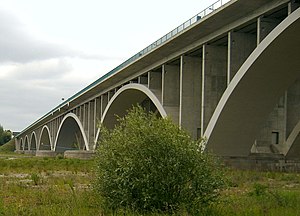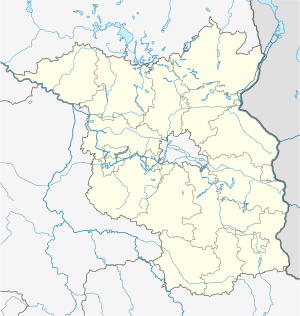Oder Bridge Frankfurt (A 12)
Coordinates: 52 ° 18 ′ 56 ″ N , 14 ° 34 ′ 42 ″ E
|
|
||
|---|---|---|
| South bridge | ||
| Convicted |
Bundesautobahn 12 Autobahn A2 |
|
| Subjugated | Or , km 580 | |
| place | Frankfurt (Oder) , Świecko | |
| construction | Reinforced concrete arch bridge | |
| overall length | 581.22 m | |
| width | 15.25 m, 14.65 m | |
| Longest span | 92.47 m | |
| location | ||
|
|
||
The Oderbrücke Frankfurt is a bridge structure on the federal highway 12 and spans the Oder and the diked foreland near Frankfurt (Oder) . The structure connects the German and Polish motorway networks. The state border between the two countries runs in the middle of the fairway on the Oder.
history
On September 22nd, 1934, construction of the Reichsautobahn began between Fürstenwalde / Spree and Frankfurt (Oder). The section was completed on August 6, 1937, and on November 27 it was open to Berlin. The construction of the Oder Bridge as a continuation of the route to Poznan did not take place before the outbreak of the Second World War . That only happened from 1953, until 1957 the foundation for two superstructures and the southern superstructure with a reinforced concrete arch bridge was built. In the following decades, this was used to handle road traffic across the German-Polish border with one lane for each direction of travel.
A state treaty between Germany and Poland created the legal basis for the resumption of construction work in April 1993. A joint venture made up of a German and a Polish construction company received the order to expand and repair the bridge. The northern, new superstructure was completed in 1995. The southern superstructure was then rebuilt and extensively repaired. On December 4, 1997, the German Chancellor Helmut Kohl and the Polish Prime Minister Jerzy Buzek opened the building to traffic. The construction costs amounted to 90 million DM. In the year 2000 the border crossing and thus also the bridge were used by 7,000 vehicles, 45% of which were heavy goods vehicles. For 2015, 16,000 vehicles were forecast. Around 28,000 vehicles were counted in 2016.
construction
The reinforced concrete bridge consists of two rows in the longitudinal direction, each with seven fixed arches with clear widths of 53.4 m, 55.8 m, 60.5 m, 68.0 m, 82.3 m, 68.0 m and 62.0 m m.
The structure is 581.22 m long and has two superstructures, each with two lanes and a hard shoulder, and has a 15.25 m wide slab for the westward and a 14.65 m wide roadway to the east. These are designed as two-legged, 1.5 m high T- beams, which are mounted on the concrete arches with 7.8 m wide transverse panels at intervals of up to 8 m. The sheets have massive, rectangular, 8.0 m wide concrete cross-sections, the thickness depending on the arch span the apex m and in the 0.75 to 1.15 m fighter between 1.4 m and 2.3 m varied. The arch of the north bridge over the river opening was made with a free-spanning scaffolding with a span of 82.3 m. In the south bridge from 1957, the deck slab and stand washers were demolished and rebuilt.
literature
- Federal Ministry of Transport: Bridges and tunnels on federal highways 1998 . Verkehrsblatt-Verlag Dortmund, ISBN 3-89273-000-3 , pp. 25–32
- D. Erler: New construction and rebuilding of the Oder bridge . In: Tiefbau , 1998, No. 3, pp. 128-137
- Friedrich Standfuss, Joachim Naumann: Bridges in Germany for roads and paths. Deutscher Bundesverlag, Cologne 2006, ISBN 3-935064-41-1 , pp. 55–56.
Individual evidence
- ↑ Heimatverein Tzschetzschnow-Güldendorf: Festschrift on the occasion of the 775th anniversary. July 2005 ( Memento from November 14, 2012 in the Internet Archive )
- ^ State of Brandenburg, Ministry for Urban Development, Housing and Transport: Border Crossings Federal Republic of Germany - Republic of Poland . Brochure, October 2003 (PDF file; 1.73 MB)



